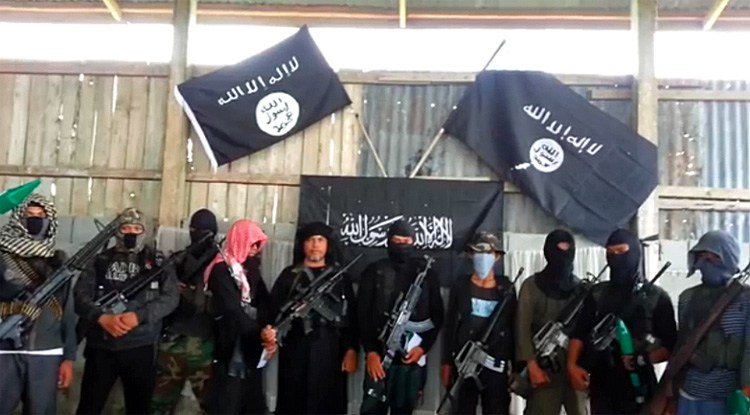The crisis in Marawi City is nearing its second month, yet the fighting rages on. One of the main impasse the Armed Forces of the Philippines (AFP) faced is how adept their opponents were compared to them with urban warfare. What the military found more surprising was that the Islamic State militants employed effective weapons that penetrated their armoured vehicles and pinned down their troops.

The reason for those problems may be because the militants they are facing are not the same terrorists the AFP have been accustomed to fighting for decades in the mountains and rural areas of Mindanao. The Maute-ISIS militants boast several veterans in their ranks, these are foreign fighters who fought in Mosul in Iraq and the greater war in the Middle East between ISIS and coalition forces.
Reports of foreign fighters in Marawi surfaced as early as the first few days of fighting, with the Defense Secretary Delfin Lorenzana stating that “eight foreign-looking terrorists” were slain in the conflict. The bodies were identified to be Malaysians, Indonesians, Saudi Arabians, a Yemeni and a Chechen.
It is not rare to hear of Malaysian or Indonesian terrorists prowling in the remote areas of Mindanao, given the relative proximity of their countries to the region. The same cannot be said of Chechen or Yemeni fighters however.
Weeks later, more foreigners were reported to have been killed with reports of “two Arab-looking bodies” recovered from the conflict zone. Western Mindanao Command chief Lt. Gen. Carlito Galvez added that intelligence from captured Maute fighters indicate that as many as 10-15 foreigners are with the terrorists, providing bomb-making expertise as well as being efficient snipers themselves.

Then followed a more haunting intelligence report released by the AFP, stating that as many as 89 foreigners are involved in the Marawi conflict. They comprise of Pakistanis, Indonesians, Arabs, Bangladeshis and Singaporeans who are providing funding, bomb-making expertise and other military help to their Filipino counterparts. That report is corroborated by a news report from Tempo.co stating that “dozens of Indonesians” were involved in the battle.
It comes as no surprise then that the battle has lasted longer than anticipated and has also proved to be bloodier than previous experiences of terrorist attacks. The Marawi Conflict is different in that it is a global effort that is plaguing the AFP, a military used to fighting ill-equipped and badly-trained ragtag militants in a jungle setting. In Marawi, the AFP are tasked with fighting in an urban environment against forces that have honed their urban guerrilla warfare techniques and are well-funded by overseas financiers.
The breakout of the fighting is the apotheosis of years of neglect by the Philippine government of the extremism that was breeding in the Mindanao region. Reports of Abu Sayyaf leader Isnilon Hapilon – one of the leaders of the Marawi siege – swearing allegiance to the Islamic State first came about as early as 2014. A study from the Brookings Institute further backed the threat, declaring that ISIS have made their way into South-East Asia after experiencing setbacks in the Middle East.

Despite those warnings, the then-government of President Benigno Aquino III downplayed any talk of an Islamic State presence in the Philippines. He regarded their pledge of allegiance as an exhibitionist act aimed at enhancing their own reputations, adding they are “just riding on the prominence of the ISIS threat.”
Aquino at that time blamed the terrorist insurgency in Mindanao on the “lack of economic opportunities rather than based on ideologies or even religious extremism.” He failed to acknowledge that the porous borders of the Philippines were bigger factors than the lack of social welfare, with Palawan and Tawi-Tawi being key entry points of gun smugglers and bomb-making experts from Borneo and elsewhere.
However, much of the blame should also go to the incumbent administration of President Rodrigo Duterte. Since taking office, he has shown an impractical and unhealthy obsession with the “war on drugs”. Not taking anything away from the importance of stamping out illegal drugs, but his current approach is myopic and is causing neglect of other pressing concerns such as terrorism in his home island of Mindanao.
Perhaps an article by South-East Asian conflict expert Zachary Abuza can make Duterte fully appreciate the danger looming in his own backyard, where the author states that another Marawi-style terrorist attack is “likely to occur” again in the Philippines. In it, Abuza makes the same assessments this essay makes which makes an attack conducive: unchecked borders, proliferation of smuggled weapons, grievance of the local populace and the draw of foreign fighters – a reality given the close proximity of the Philippines to populations of frustrated Muslims such as the Rohingyas in Myanmar, Uighurs in China, Southern Thailand and Aceh province in Indonesia.
The challenge for Rodrigo Duterte now is for him to treat the war on terror with the same significance and focus as his war on drugs. He has correctly identified Mindanao to have been a growing breeding ground for the drug trade in the country, though he also needs to recognize that it is not only drugs that is breeding but also extremism. If the conflict in Marawi already proved a tall order for his troops to topple, what would future attacks look like?

